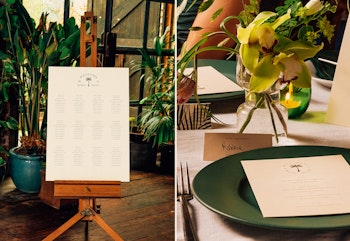Planning a wedding is filled with opportunities to get creative and impress your guests. Your wedding seating chart is one special touch that’s sure to be seen by all, so going the extra mile can really pay off. The first detail to greet your guests when they arrive at the reception, your wedding seating chart ensures that everyone finds their seat and heads to the right table, without any confusion or delay. Having a seating plan also makes it much easier for the catering staff to navigate the service, especially if there are any special dietary requirements.
But deciding on what the finished product looks like and who should sit where (to avoid any potentially awkward situations) can quickly turn into a time-consuming headache. With that in mind, we’ve gathered our golden rules and top tips to help you create an ideal wedding table plan that will ensure your guests enjoy a celebration to remember.

Go for themed wedding table names
Depending on how many guests you’re expecting and the kind of space in which you’re holding your wedding, it’s always a smart idea to divide your nearest and dearest up into several tables. Doing this according to a theme is a fun way of showcasing your personality or something that’s significant to you as a couple. For example, you might both be keen adventurers and decide to have the table names after a favorite destination. Or if you’re both literature fans, you could name each table after a novel or an author that’s dear to you. Not only will this add a highly personal touch to your big day, it’s also a great icebreaker for guests who don’t necessarily know one another.
What is the ideal number of people per table?
Before you start playing real life musical chairs with your guests, you’ll need to come up with some sort of plan. Not only will the shape and size of your tables dictate how many people can be comfortably seated, but it will also set the tone. While long rectangular tables have a festive banquet feel and the added bonus of greater capacity, round tables allow for more intimate conversations. If you can, get a copy of the venue’s floor plan and play around with the different options to see what works best for you and your guests.

Where to seat your nearest and dearest
Once your guestlist is final, it’s time to get started on your wedding seating plan. It’s up to you to decide which combination of family members, friends, and co-workers will best get along. This doesn’t mean you have to group them together, but you might want to put people who already know each other in close proximity, or consider their age, interests and backgrounds to determine which guests are likely to have the most in common.
Ideally, each table should have a mix of familiar and new faces. You could also consider simply assigning tables rather than specific seats. This way, your wedding guests will still have some direction but will also be free to make their own choices. Just as you would with a more detailed wedding seating chart, put some thought into who you’ll be grouping together so that each of your guests has someone to talk to and is sure to have a good time. And if you choose to forgo assigned seats, do make sure your guests have a designated place to sit down and rest from the festivities.
Who gets to sit at the head table?
The head table is usually reserved to the guests of honor, loved ones such as the parents of the newlyweds and their closest friends. But if you’re looking to break with tradition, a sweetheart table – where you and your partner have your own private table – can also be a great option. It can offer you intimacy and privacy on a day when you’ll be spending most of your time talking to other people, plus it’s a wonderful way for you to enjoy your reception together.

The ‘couples’ rule
In the interest of mixing things up, it might seem like a good idea to split couples up for the evening, the logic being that they already spend most of their time together. However, you want your guests to be comfortable and for some, that might mean having their partner or the person they came with close by. If you’re looking to compromise, keep couples on the same table but seat them next to people they’re less familiar with.
The ‘singles and kids’ rule
Whether they’ve come without a plus one, or don’t know anyone other than you, it might be tempting to put all the odd guests on one table. Instead, try and include them at other tables, with other guests that they might have something in common with. If you’re inviting kids to your wedding, you might decide to seat them all together depending on their ages. Make them feel special by giving them their own table and personalized menus, or add some table games to keep them entertained.
Pick your design
Now that you’ve finally finalized your seating arrangements and your tables, it’s time for the fun part: personalizing your wedding seating chart. Before you start, ask yourself what the overarching style of your big day is and try to isolate the visual elements that will best represent it. If you’ve chosen to name your tables after a common theme, go with a design that embodies it visually and brings the concept to life. You can also personalize your wedding table plan with beautiful calligraphy or hand-drawn illustrations. Asking some of the younger guests to contribute can be a lovely way of making them feel included.
Creating the perfect wedding seating chart might seem daunting, but just remember, a little foreplanning will take you a long way. Ready to make a start on yours? Discover our collection of wedding seating chart and start personalizing your design.





